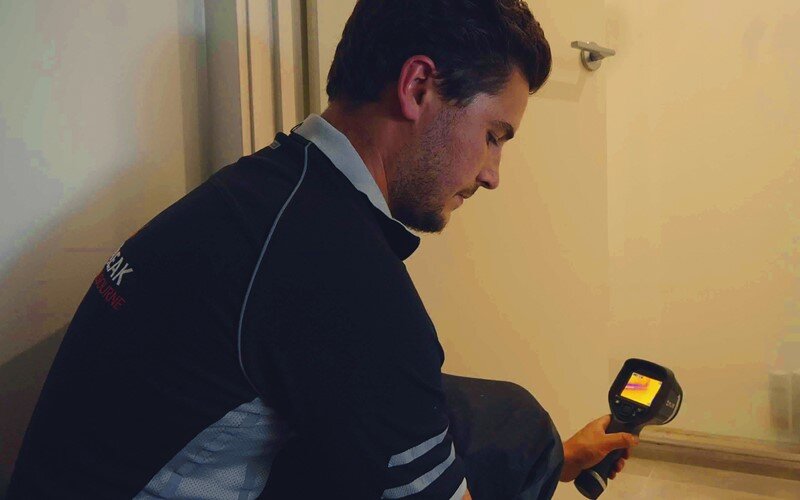This post in the next paragraphs pertaining to Finding hidden leaks is immensely attention-grabbing. Try it and make your own findings.

Early detection of dripping water lines can minimize a possible calamity. Some tiny water leakages may not be visible.
1. Examine the Water Meter
Every home has a water meter. Examining it is a proven way that assists you find leaks. For beginners, switch off all the water resources. Make certain no one will certainly flush, use the tap, shower, run the washing machine or dishwasher. From there, go to the meter and watch if it will certainly change. Considering that no person is utilizing it, there ought to be no movements. That shows a fast-moving leak if it moves. Similarly, if you identify no changes, wait an hour or 2 as well as check back once more. This suggests you might have a sluggish leakage that can also be below ground.
2. Examine Water Intake
Examine your water costs and also track your water intake. As the one paying it, you should discover if there are any kind of discrepancies. If you detect sudden changes, in spite of your usage being the same, it implies that you have leakages in your plumbing system. Bear in mind, your water bill ought to fall under the same range on a monthly basis. A sudden spike in your bill indicates a fast-moving leak.
On the other hand, a stable rise monthly, even with the very same routines, shows you have a slow-moving leak that's likewise slowly escalating. Call a plumber to extensively check your home, especially if you feel a cozy area on your floor with piping below.
3. Do a Food Coloring Test
When it comes to water consumption, 30% comes from commodes. If the shade in some way infiltrates your dish throughout that time without flushing, there's a leak in between the tank and also dish.
4. Asses Outside Lines
Do not fail to remember to inspect your outdoor water lines also. Examination spigots by attaching a yard hose pipe. Must water seep out of the link, you have a loosened rubber gasket. Replace this and also make sure all links are tight. It will certainly help get it skillfully checked out and maintained yearly if you've got a lawn sprinkler system. One small leakage can throw away lots of water and spike your water bill.
5. Evaluate the situation and also check
Property owners should make it a behavior to inspect under the sink counters and also inside cupboards for any kind of bad odor or mold development. These two warnings indicate a leakage so prompt interest is called for. Doing routine inspections, even bi-annually, can conserve you from a major problem.
Inspect for discolorations as well as weakening as the majority of devices and pipelines have a life expectations. If you think dripping water lines in your plumbing system, don't wait for it to intensify.
Early discovery of dripping water lines can reduce a prospective calamity. Some tiny water leaks may not be visible. Inspecting it is a guaranteed means that aids you discover leaks. One tiny leak can squander heaps of water and also increase your water costs.
If you suspect leaking water lines in your plumbing system, do not wait for it to rise.
How to Know If Your Home Has a Hidden Leak
Water Meter Reveals Inexplicable Water Usage
If you’d like to test whether or not there’s a leak somewhere in your home, you can do this using your water meter. Here is how to conduct the test:
Don’t use any water in your home for at least 30 minutes; this also means not turning on faucets or water-using appliances.
Go outside, and check your water meter for activity.
If your water meter shows that there was activity, even though no one was using any water, this proves that there is a leak in your home.Visible Mold or Mildew Growth
Leaks behind walls create moist, dark environments that allow mold and mildew to grow and thrive. Eventually, you might see mold growth forming on the wall closest to a hidden leak.
If mold is growing in an area that receives a high amount of moisture, such as a bathroom, it may simply be an indication that better ventilation is needed. However, if you see mold growth on a wall or the ceiling in an area where you would not expect, you probably have a hidden leak.
Musty, Mildew Odor
Sometimes you might not be able to see the mold or mildew that is growing as a result of a leak. However, the smell can give the problem away just as easily. If you catch a whiff of something musty, there’s a good chance that old water is collecting somewhere in your home that you can’t see.
Stained/Warped Walls, Ceilings, or Floors
When your home soaks up water, a variety of red flags can become visible, including ceiling stains, bubbling drywall, warped walls, and sagging floors. While these issues can be caused by excess humidity, they can also be signs that a pipe or plumbing connection has started leaking behind your walls.
Inexplicably High Water Bill
After a while, you get a general sense for what your water bill should be. If you own a pool or sprinkler system, your bill will tend to be higher during summer. However, if you receive a water bill that seems especially high, and you can’t figure out what caused it, then you may have a hidden leak somewhere that’s increasing your bill.
https://www.plumbingjoint.com/blog/2019/july/how-to-know-if-your-home-has-a-hidden-leak/

We had been made aware of that report about Detecting hidden plumbing leaks through an acquaintance on another web blog. Do you know about another individual who is serious about the niche? Feel free to share it. I recognize the value of reading our article about Detecting hidden plumbing leaks.